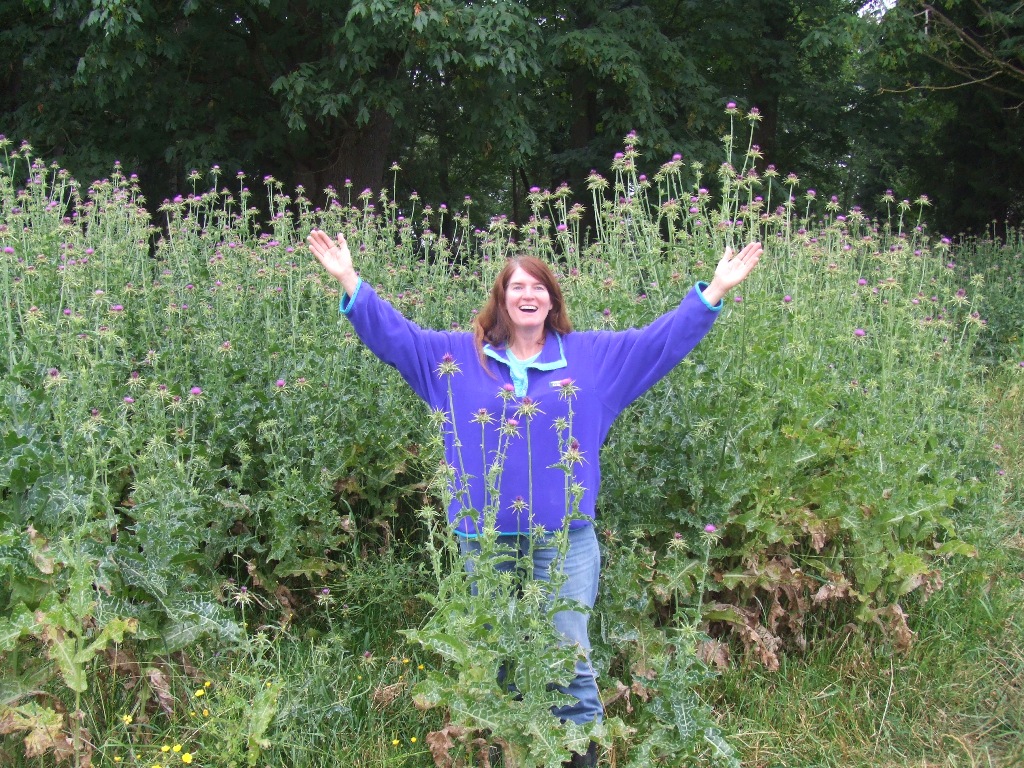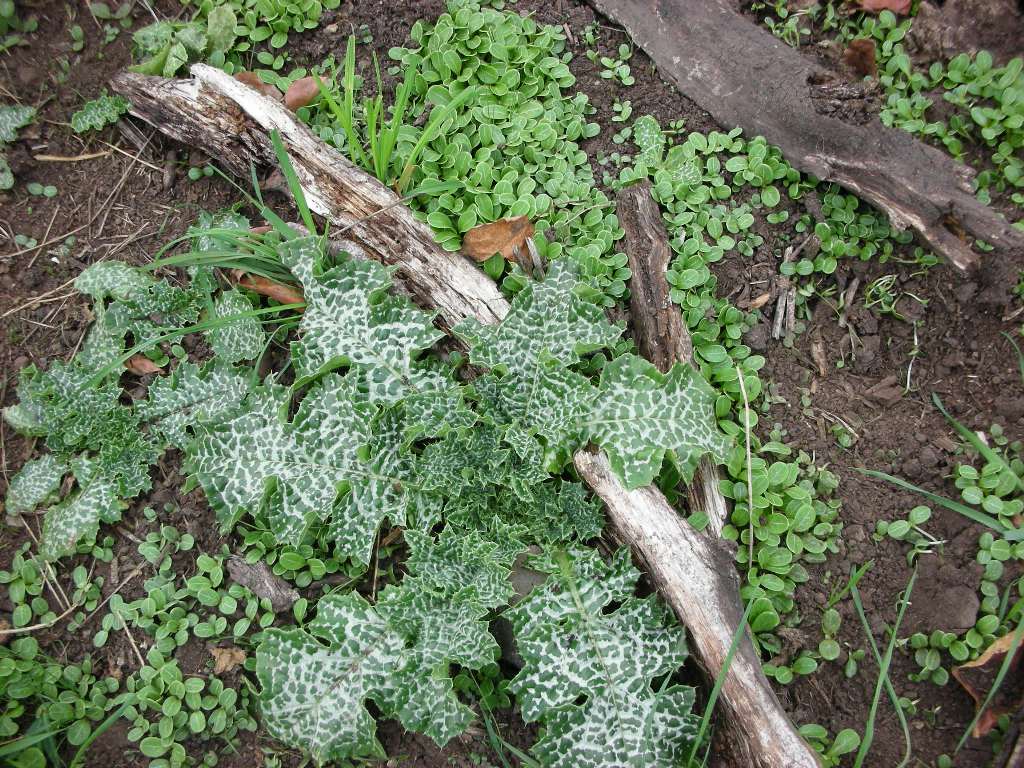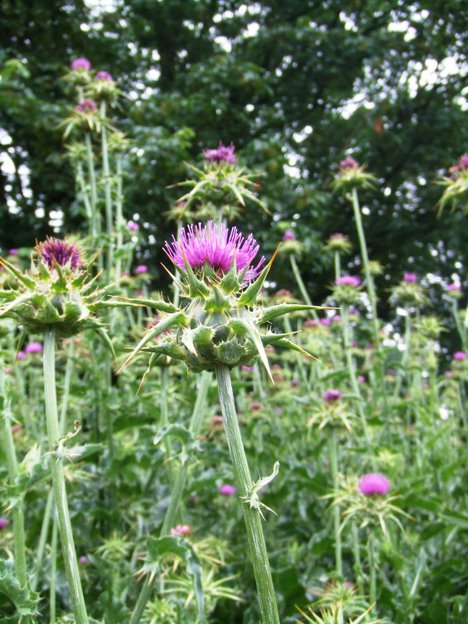Milk thistle identification and control
Information about the noxious weed milk thistle. Milk thistle is also known by its Latin name, Silybum marianum. Property owners are required to control this plant. Milk thistle can cause nitrate poisoning in cattle and sheep.
About this weed
Milk thistle is a regulated Class A noxious weed. This means eradication is required state-wide. Milk thistle is also on the Washington quarantine list.
Milk thistle, known as Silybum marianum, is in the aster family (also called the sunflower family). Other common names used for this plant are blessed milk thistle, spotted thistle, and variegated thistle.

Why it's a problem
Milk thistle is a regulated noxious weed because it is harmful to some animals and spreads aggressively. It outcompetes native and beneficial vegetation. Left alone, it forms dense stands in pastures and rangeland, reducing the forage value of the land.
Milk thistle can cause nitrate poisoning in cattle and sheep if large amounts of the plant are ingested. Observed signs may occur 6 to 8 hours after consumption. They include sudden weakness or drowsiness, rapid pulse, difficulty breathing, muscle tremors, and convulsions. If you start to notice these signs in your animal, seek emergency help from a veterinarian immediately.
In excess, it can cause gastrointestinal issues in dogs. Most animals avoid this plant due to its vicious spines. Animals are more likely to eat it once the leaves begin wilting.
This plant has a limited distribution in King County, concentrated in rural areas. Because of this, we still have a chance to eradicate it before it spreads further.
Plant description
Milk thistle is native to Europe and was brought to North America by early colonists. The above-ground parts and seeds are sometimes used to make medicine. It is usually found in areas with full or partial sun and disturbed soils (such as pastures, roadsides, ditches, and fencerows).
Milk thistle is a winter annual (1-year life cycle beginning in fall) or biennial (2-year life cycle). It germinates in the fall showing 2 round cotyledons (first leaves) with simple white veins. It will grow to a larger spiny rosette (circular cluster of leaves on ground level) over the winter.
The leaves are large and shiny green with white marbling. In the spring and early summer plants can grow over 6 feet tall with a large taproot. Milk thistle grows bright magenta or purple flowers with thick, spine-tipped bracts around the base of the flowerhead. Leaves, stems, and flowers are all armed with stiff, sharp spines.
Milk thistle reproduces by seed; each plant produces over 6,000 seeds every year. Seeds can remain viable in the soil for over 9 years.




.jpg?h=3024&iar=0&w=4032&rev=4422234b8c9848ed9350aa69c65c48dd&hash=62F35078DEA91E6C77BBD40B0DE38EDD)
.jpg?h=2499&iar=0&w=2739&rev=9b3fdf81a3a741d4b72fe776e4c6d916&hash=F5C8000488AC72F3E125582C993A42E9)
Be aware of look-alike plants
Milk thistle is often confused with:
When in doubt, take photos and share them with us or report them on iNaturalist.
What to do if you find it
Notify us if you see milk thistle in King County. Our program staff can provide you with site-specific advice on how best to remove it.
We map all known locations of regulated noxious weeds to help locate new infestations in time to control them.
Control methods
We recommend using a combination of methods to control noxious weeds. In areas with few weeds, it is important to act quickly before they become harder to control. Make a long-term plan as it often takes several years to get rid of most weeds. Start in the least infested areas first and then move into more heavily infested areas.
For more in-depth control information, read Best Management Practices (BMP) for milk thistle (615KB)
Manual control
Wear sturdy gloves to avoid getting hurt by sharp spines. Dig up plants ideally before seed heads form. Try to remove as much root as possible. Remove and bag seed and flower heads, if present.
Mechanical control
Mowing works only if done frequently. Only mow if flowers and seed heads are absent. To reduce regrowth, use manual tools (such as brush cutters, machetes, or loppers) to cut plants at or below ground level. Always clean equipment afterwards to avoid spreading seeds.
Cultural control
Maintain healthy, non-invasive, competitive grasses. Sustainable grazing practices support healthier perennial grass populations to compete with weeds. Goats can graze with no ill effects but keep cattle and sheep away. Horses may be injured by the sharp spines.
Chemical control
Stay safe when using herbicide:
- Always read the label before use.
- Wear a long-sleeved shirt, long pants, shoes, and eye protection.
- Follow state and local regulations.
Foliar, broadleaf herbicides are effective on growing plants in the spring and fall. Selective herbicides (such as triclopyr, 2,4-D, aminopyralid) are best. Non-selective herbicides (such as glyphosate) will harm grasses and should only be used where damage to grass is not a concern. Do not cut treated plants until they have died (2 weeks or more after treatment).
Be aware there may be additional herbicide restrictions when pastures are grazed, especially by lactating dairy animals.
For specific chemical recommendations, please refer to the PNW Weed Management Handbook.
Disposal instructions
On site composting is okay if livestock, other than goats, are not present. If livestock are present, you can compost all but the flower and seed heads. Always remove flower and seed heads if present and dispose in garbage. Do not compost. Compost does not get hot enough to kill all the seeds.
Noxious Weed Disposal - Washington State Noxious Weed Control Board

 Translate
Translate